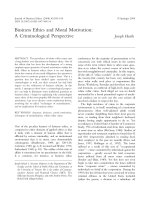Global business ethics lesson 07
Bạn đang xem bản rút gọn của tài liệu. Xem và tải ngay bản đầy đủ của tài liệu tại đây (1.42 MB, 12 trang )
65
Discrimination
LESSON
7
DISCRIMINATION
CONTENTS
7.0
Aims and Objectives
7.1
Introduction
7.2
Harassment
7.3
7.2.1
Sexual Harassment in Certain Industries
7.2.2
Preventing Sexual Harassment at the Work Place
7.2.3
Sexual Harassment Policy
Discrimination
7.3.1
Discriminatory Practices
7.3.2
Source of Discrimination
7.4
Racism on the Job
7.5
What the Law Says
7.6
Tracking the Problem
7.7
Let us Sum up
7.8
Lesson End Activity
7.9
Keywords
7.10
Questions for Discussion
7.11
Suggested Readings
7.0 AIMS AND OBJECTIVES
After studying this lesson, you should be able to understand:
z
The harassment and discrimination
z
The methods of avoiding discrimination
z
The sources of discrimination
z
The racism on the job
7.1 INTRODUCTION
Every member is like a field of force in the market and in the society in which, he/she
operates. When so many forces interact the resultant force is likely to drag an
unwilling member in a direction in which he (or) she does not want to move. This
happens among the two sexes, the people in different age groups, religious beliefs and
value systems. Cost, creed and religion also interfere in the peace and harmony of the
society. Though it is said that ‘Blood is thicker than water’ everyone is same under the
skin. Therefore the individual freedom honor and liberty should never be tampered
with.
66
Global Business Ethics
7.2 HARASSMENT
Harassment at the work place has become one of the complex problems facing
organisations. Organisations across the world are witnessing protests and
encountering lawsuits from the victims in terms of millions of dollars of
compensation. The former have been compiled to look into the issue and are also
initiating strategic policies to create a harassment free environment, where in both
men and women work together for the organisational growth and development. Many
organisations have relieved the cost of sexual harassment and hence accepted their
responsibility to prevent it by establishing programmers to deal with sexual
harassment on the job.
Harassment is defined as an unwanted conduct of a sexual nature or other behaviors
that affects the dignity of men and women at work. This includes uninvited and
unwelcome physical, verbal or nonverbal conduct.
This may include:
Touching, Jokes, Remarks, Use of sexually explicit language, Looks, References to a
person's private life attitudes, Sexual Innuendoes with a sexual connotation,
Comments on dress, Persistent leering at a person or at part of his/her body.
7.2.1 Sexual Harassment in Certain Industries
z
Cinema industry
z
Airline industry
A study conducted in Australia, more than one-half of the sample of cabin attendants
who were interviewed have admitted that they have been harassed. In Cinema
industry, it is equally bad where the female jobs are more equal to men's job, such
harassments are more. Reports from Japanese airlines also says that there is a steep
increases of abuses and attacks on cabin crews, which have almost tripled in 1996.
Many a times the cases of sexual harassment don't come to light. If it is publicly made
known for the women in India about the harassment, they would be in rough weather
from the society. Unmarried girls may not get suitable partners. Hence such matters
will be hushed up by the parents.
ILO's study on violence at the work place shows that it is a serious issue. It has
become no more extraordinary phenomenon but a matter of daily incidence. The
incidence noted in European countries are as under:
z
Germany 93%; UK-73%; Netherlands-58%: Spain-40%; Norway- 41%; In Japan
too, because Of severe recession resulting in down sizing of industries, large
number of women complain of sexual harassment as per the Tokyo Manager's
union.
z
We have read in news papers about the court cases of Clinton and Lewinski and
as well as a case in a leading IT firm at Bangalore 'Infosys Technologies.'
Employees tend to be creative and innovative in their jobs. Motivated employees want
to do a good job. If work place is smeared by any kid of harassment, they face
difficulties in focusing attention to their jobs - Inappropriate behaviour goes
unchallenged as we tend to accept them in offensive. Many a times, fear of reprisals or
ostracism comes in the way of lodging a formal complaint against a fellow worker,
even though his/her behaviour is bad/worse. Such meek acceptance leads to
psychologically wrecking situations, which finally becomes unbearable for the
victims.
67
Discrimination
Figure 7.1: Different Types of Sexual Harassment (Major)
Sexual harassment has become a concern to their employers who treats it as a
disciplinary offence; earlier regarded as personal dispute between employees in which
the employer was in no way involved.
The problem has grown like a mushroom.
7.2.2 Preventing Sexual Harassment at the Work Place
z
Strong company policies to be formulated.
z
Company's policies are to be enforced.
z
Early/continuous training to employees provided.
z
Communicate sexual harassment policies on a regular basis.
z
Prevention is the best tool to prevent the same from occurring. Mention clearly to
the employees that sexual harassment will not be tolerated. In some countries like
Saudi Arabia, stringent punishments are given to the abused.
z
Supreme Court in India has issued guidelines for this. Experts feel sexual
harassment is imperative to think comprehensively. Instead of searching for the
single solution good for any problem and situation, the full range of causes, which
lead to sexual harassment, should be analyzed and a variety of intervention
strategies executed. Enhancement of security for workers, providing rehabilitation
and psychological counseling etc. is required to help victims to cope with the
aftermath of such violence at the work place.
68
Global Business Ethics
1
Developing a firm policy against Harassment
Major Features of
Programs
2
Computing the policy to all employees and
providing training, where necessary to secure
compliance
3
Setting up an procedure for reporting violations;
Investigating all complaints thoroughly and fairly
are
4
Taking appropriate action against the offenders
Figure 7.2: Major Features of Programmes to deal with Sexual Harassment
7.2.3 Sexual Harassment Policy
A firm statement is issued at the high level in the organisation that certain conduct
will not be tolerated. The policy statement should convey:
1. The serious intent of management
2. The kind of actions that constitute sexual harassment
3. The policy should educate and also warn.
Communicating the Policy to all the Members of the Organisation
This is to be done properly. Effective communication involves making the policy
known to every one gaining understanding and acceptance of the policy. Most of the
companies include sexual harassment awareness in initial training programmes in
their job training/implant training, ongoing education programmes, utilize videos of
situations, simulation games to heighten employee sensitivity to the issues
Setting up a Procedure for Reporting Violations
z
Policy should include a well publicized procedure for handling incidents of sexual
harassment with assurances of non-retaliation against an accuser. For making a
complaint, employees should be informed about the procedure to follow like:
z
Specific person/office to which complaints to be made
z
Alternatives available to them for making complaints.
z
Those who handle complaints should be aware of the procedure to follow
z
Further, the policy on the whole should assure all parties about confidentiality
z
From the accuser
z
From the accused
z
The investigation should take place with relevant facts and the rules of due
process, in view of the harm that might result from false accusations. Though
ideal to have a formal complaint procedure, companies can have an informal
process through which a situation may be resolved to the satisfaction of an victim,
with a well suited for less serious, infrequent incidents among peers.
Taking appropriate action or any disciplinary action like:
z
Reprimand
z
Pay reduction
z
Job transfer
z
Loss of a bonus
z
Demotion
z
Termination
Should aim at a minimum to deter the offender and perhaps to deter others in the
organisation. The victims of harassment might have suffered some job loss or
have been deprived of some opportunities. Hence a proper resolution may also
include compensating the victims for harm done.
Eight principles had been recommended for the creation of harassment free work
place:
z
Top management must stress that sexual harassment policy with clearly defined
procedures that demonstrate top management’s conviction to eliminate sexual
harassment.
z
The organisation managers must understand the policy and adhere to its contents.
z
The organisation must create an atmosphere of open communication and trust in
which employees can voice their concerns.
z
The organisation must recognize that there can be “impact without intent”, but
that ignorance of the law is no excuse.
z
The sexual harassment policy should recognize that unwelcome behavior is “in
the eye of the beholder”.
z
All employees must be educated about what constitutes harassment and have the
trust to respond promptly and appropriately.
z
The company must periodically review, adjust, and reinforce each of these steps.
7.3 DISCRIMINATION
Discrimination describes a large number of wrongful acts in employment, housing,
education, medical care and other important areas of public life. This takes different
forms in the above areas. What is common is that a person due to the above is
deprived of some benefit, opportunity because of membership in some group toward
which there is substantial prejudice.
Today’s work place, although diverse, is ridden with discrimination of various kinds.
Discrimination can occur based on gender, age, disability, race, religion, nationality,
etc.
It is a form of unequal treatment but not all unequal treatment is discrimination. An
employer shows favouratism in deciding promotions.
69
Discrimination
70
Global Business Ethics
Discrimination
Elements
Involves decision that directly affect the
employment status of individuals / terms
and candidates of the employment
The unequal treatment results from prejudice or
some other morally unjustified attitude against
members of the group to which an individual
begins; Individuals are not treated on the basis of
individual merit but on the basis of membership
in a group.
Figure 7.3: Discrimination Elements
Employment policies that do not explicitly involve classifying employees by race, sex,
religion or other impermissible characteristics can still serve to exclude members of
these groups in disproportionate numbers,
Discrimination is not solely a matter of intention but also of consequences. 'Disparate
treatment' is the discrimination of the first kind while the latter is 'disparate impact'.
The various forms of discrimination are shown below:
Treated differently in order to have
less compensation
Determination against the
Handicapped
On the basis of Sex
Age Discrimination
Younger employees preferred by
shunting old ones to have more
update skills and innovative basis
Based on male or female and not
on the sex related matter such as
sexual orientation or martial status
Discrimination
Forms
Religious discrimination
Natural Origin Discrimination
Employer could have employment policies
that exclude Mexicans but not others like
Vietnamese, Indians
This is different from discrimination
based on sex or race. E.g., Employers
refuse to hire or promote individuals
because they are Jews, Indians etc, in
US
Figure 7.4: Discrimination Forms
Check Your Progress 1
Define the following:
1. Harassment
……………………………………………………………………………
……………………………………………………………………………
2. Discrimination
……………………………………………………………………………
……………………………………………………………………………
7.3.1 Discriminatory Practices
71
Discrimination
The discriminatory practices now widely recognised are as under:
Conditions of
Employment
Recruitment
Practices
Discriminatory
Practices
Promotion
Practices
Screening
Practices
Figure 7.5: Discriminatory Practices
Recruitment Practices
Firms that rely solely on the word-of-mouth referrals of present employees to recruit
new workers tend to recruit only from those racial and sexual groups that are
represented in their labour force. For example: If the firm's labour force is only Hindu
community males, this recruitment policy will tend to discriminate other religions and
women.
Screening Practices
Job qualifications are discriminatory when they are not relevant to the job to be
performed. Aptitude or intelligence tests used to screen applicants become
discriminatory when they serve to disqualify members from minority cultures who are
unfamiliar with the language, concepts and social situations used in the tests but who
are in fact fully qualified for the job.
Promotion Practices
Promotion, job progression and transfer practices are discriminatory when employers
place majority on job tracks separate from those open to women and minors (Similar
to recruitment practices e.g. Hindu males as compared to other communities and
women).
Conditions of Employment
Wages and salaries are discriminatory to the extent that equal wages and salaries are
not given to people who are doing essentially the same work. Fixing an employee on
the basis of his/her race or sex is a clear form of discrimination. Layoff policies that
rely on a seniority system wherein women and minorities have the lowest seniority
because of past discrimination.
72
Global Business Ethics
Figure 7.6: A Policy for Non-discrimination
7.3.2 Source of Discrimination
Discrimination during the Recruitment Process
No matter whether employers are recruiting through employment agencies, job
centres, careers offices or schools, they have a duty not to discriminate on the grounds
of sex (including gender reassignment), sexual orientation, race, marital status,
disability, membership or non-membership of a trade union, and religion or religious
belief.
They must neither give instructions nor bring pressure to discriminate in any of these
ways. In relation to pregnancy, any decision not to appoint a woman on the grounds
that she is pregnant is likely to be found to be discriminatory against sex.
Exceptions: There are some jobs for which the sex or race of the successful candidate
may be a genuine occupational qualification' and in these circumstances
discrimination in advertisements, in the interview procedure, in job offers, in offers of
promotion, training or transfers is acceptable.
Sex
A person's gender is a genuine occupational qualification for a job in the following
circumstances:
Where the essential nature of the job calls for someone of a certain sex for reason of
physiology, e.g. a female model.
Where it is necessary to preserve decency or privacy, because the job is likely to
involve physical contact with people of the opposite sex in circumstances where those
people may reasonably object to the job holder being of the opposite sex, or because
the holder of the job is likely to do work in the presence of people who are in a state
of undress or are using sanitary facilities and therefore might reasonably object to the
presence of a person of the opposite sex. The application of this genuine occupational
qualification depends on all the circumstances; it must be necessary rather than merely
preferable to have a member of the opposite sex in question to perform the job.
Being a woman is not necessarily a genuine occupational qualification for a job as a
nanny or domestic help; each case depends on its own facts. If, for example, the
mother likes to bath with the baby and the nanny is expected to come into the
bathroom during bath-times, this is a factor which may be taken into account in
assisting a defense of sex discrimination by a male nanny who is unsuccessful against
a woman in a job application. However, in many cases concerning male nannies, the
genuine occupational qualification defense will not apply.
Where the nature or location of the job means that the jobholder must live in the
premises provided by the employer. Because it is impractical for them to live
anywhere else and the premises are not equipped with separate sleeping
accommodation or sanitary facilities for men and women, it is unreasonable to expect
the employer to equip the premises with such accommodation or facilities.
Where the job is in a single-sex establishment or single-sex part of an establishment
for people requiring special care, supervision or attention, and the essential character
of that establishment or that part makes it reasonable to restrict the job to a person of
the same sex as those for whom the establishment or that part of it exists.
Where the job is for the provision of personal services to people in order to promote
their welfare, education or other similar services and those services can most
effectively be provided by someone of a certain sex.
Where the job involves working outside the UK in a country whose laws and customs
are such that the duties could not, or could not effectively be performed by a man (or
by a woman).
Where the job is one of two held by a married couple.
Race
A person's race is a 'genuine occupational qualification' for a job in the following
circumstances:
1. Where the job involves dramatic performance and someone of a particular racial
group is required for authenticity.
2. Where the job involves working as a model for producing works of art, picture or
film and a person of a racial group is needed for authenticity.
3. Where the job involves working in a restaurant open to the public in a particular
setting for which someone of a particular racial group is required for authenticity.
4. Where the job involves the provision of personal services to a particular racial
group in order to promote their welfare and those services can be best provided by
someone from the same racial group.
As with sex and race discrimination, there are some jobs for which the sexual
orientation or religion or belief of the candidate may be a genuine occupational
qualification.
Age
There is no express legislation prohibiting discrimination on the grounds of age, but
there is a voluntary code of practice which attempts to tackle the problem of age
discrimination. The Government has announced proposals to introduce laws to stop
age discrimination by 2006.
Colour blindness what are the rules and the reality about racism in recruitment and the
workplace in Ireland?
For the first time, Ireland is opening its doors to significant numbers of people from
different countries and racial backgrounds. In such a situation, the monster of racism
inevitably rears up.
Colour of Money
Racism affects decisions about employment before a person even gets a job, in the
recruitment process. This includes throwing out applications with 'foreign' names and
73
Discrimination
74
Global Business Ethics
assuming that nationals of other countries are less likely to have the right to work in
Ireland or grasp a sufficient level of English.
Some employers may be intentionally racist, disliking Africans and refusing to hire
them. Others may not think of themselves as racist but may never end up hiring, for
example, an Asian man, because of a subconscious belief that Asian men are sexist.
Much of this sort of discrimination goes unnoticed and undocumented. Even in the
UK, where ethnic monitoring of applications has been standard practice for many
years, it is difficult to prove that an employer discriminates on racial grounds in
recruitment.
Think about it. How many applicants who fail to get a job ever find out the reason
why? How many will ever know who actually got the position and what factors were
taken into account?
Most companies recruit people not only on the strength of their qualifications but also
on the basis that they will work well with colleagues. Here the employer may consider
race and nationality important to 'fitting in' with the existing team.
One construction industry personnel manager explains the concerns his bosses had
when deciding whether to employ a Nigerian forklift driver: "It was pure racism –
there were no actual grounds. They were worried about certain individuals in the
company, less evolved in their attitudes."
The attitude shift is to some extent a two-way street and there needs to be a sensitive
look at what immigrants themselves can do. In this case, the Nigerian was employed,
but when he didn’t turn up the next morning he told the manager calling up to check
on him that he didn’t want to come in because it was raining so heavily.
"There is a difference in understanding the need for an early start and time-keeping,"
the personnel manager explains. "My feeling is that this is a cultural thing, much like
the Germans see us Irish in our work ethic. There is a need for certain cultural
induction for asylum seekers, including English-language classes.
"But the one guaranteed way of us becoming a shit poor country again is to stop
immigration. All the people bitching about immigrants will have their pensions paid
by the sons and daughters of immigrants."
7.4 RACISM ON THE JOB
The evidence from countries like the UK and US suggests that being hired is only the
first hurdle that the minority employee must jump. Promotions may be withheld due
to intentional or unintentional racism. Working conditions may be anything from
lonely to downright unbearable.
Some minority staff are given the silent treatment and excluded from social activities.
Others may find themselves the objects of verbal or even physical abuse based on
their race.
Award-winning Nigerian businesswoman Felicia Olima saw the ugliest side of racism
when she first set up her IT business in Dublin.
"I had so many calls to the office telling me to leave," she said in a recent Irish Times
interview. "They went to my house and sprayed my car with acid…They said they
were going to burn the house down."
7.5 WHAT THE LAW SAYS
The Employment Equality Act (1998) makes it unlawful to discriminate against a
person in terms of access to employment, training, promotion, working conditions or
dismissal because of race (including colour, nationality and ethnic or national origins).
The act makes certain types of racial harassment the responsibility of employers, who
must do what they reasonably can to prevent it.
Discrimination is defined as the treatment of one person in a less favourable way than
another person is, has been or would be treated. Indirect discrimination on grounds of
race is also unlawful. Indirect discrimination occurs where an ostensibly neutral
requirement placed on all employees has a harsher impact on a particular group.
An employer who only accepts candidates with Irish Leaving Certificates and not
other reputable school-leaving qualifications could be guilty of discrimination on
grounds of race or nationality.
Check Your Progress 2
Define the following:
1. Sexual Harassment Policy
……………………………………………………………………………
……………………………………………………………………………
2. Law on Discrimination
……………………………………………………………………………
……………………………………………………………………………
7.6 TRACKING THE PROBLEM
What is clear from the US and UK experience is that statistical evidence is vital to
prove racism in recruitment. Employers need expert advice and support on what
measures to take to ensure that employees are not the objects of racial abuse.
Perhaps the aspect of racism that is most difficult to tackle is the subtle prejudice that
affect who is chosen for promotion or special training. Combating that sort of
discrimination is more a matter of education and awareness than of law.
It is difficult to acknowledge that every individual is created equal, and given equal
opportunities, will deliver similar results. So, discrimination keeps grabbing headlines
on a regular basis mirroring the human failure in treating all mankind on an equal
basis.
7.7 LET US SUM UP
No two objects or people or manufacturer products are totally alike. This natural
variation in people and products are essential to build up variety and interest and
growth in life .No one person or product is in anyway superior to another product or
person. It is by birth God has put us in different roles. If this is understood there will
be never be discrimination, harassment or racism in society.
7.8 LESSON END ACTIVITY
Differentiate between harassment and discrimination.
7.9 KEYWORDS
Sexual Harassment: An unwanted conduct of a sexual nature.
Discrimination: Wrongful acts in employment, education, and other important areas
of public life.
75
Discrimination
76
Global Business Ethics
7.10 QUESTIONS FOR DISCUSSION
1. Nowadays sexual harassment is predominant in certain type industries or jobs like
cinema and airline industries. Explain.
2. Explain discrimination. Give the ethical arguments against discrimination.
3. Explain the working condition with regard to health and safety and job
satisfaction.
Check Your Progress: Model Answers
CYP 1
1.
Harassment is defined as an unwanted conduct of a sexual nature or other
behaviors that affects the dignity of men and women at work. This
includes uninvited and unwelcome physical, verbal or nonverbal conduct.
2.
Discrimination describes a large number of wrongful acts in employment,
housing, education, medical care and other important areas of public life.
This takes different forms in the above areas.
CYP 2
1.
A firm statement is issued at the high level in the organisation that certain
conduct will not be tolerated. The policy statement should convey:
a) The serious intent of management
b) Describes the kind of actions that constitute sexual harassment
c) The policy should educate and also warn.
2.
The Employment Equality Act (1998) makes it unlawful to discriminate
against a person in terms of access to employment, training, promotion,
working conditions or dismissal because of race (including colour,
nationality and ethnic or national origins).
7.11 SUGGESTED READINGS
Manuel G. Velasquez, Business Ethics.
Laura P. Hart Man, Business Ethics.
John R. Boat Right, Ethics in Conduct of Business.
William A. Wines, Ethics Law and Business.









